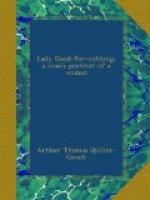1. Thomas, the third Baronet: of whom anon.
2. William, who became a Senior Student of Christ
Church, Oxford, a
page to Queen Mary, and a
Fellow of the Royal Society. A memoir
of the time preserves him
for us as “a tall sanguineman, with a
merry eye and talkative in
his cups.” He married a Walpole, but his
children died young.
3. John, who, going on a diplomatic mission
to Hamburg, took a fever
and died there, unmarried.
4. Henry, the father of our Collector.
He married Jane, second
daughter of the Marquis of
Lomond; increased his wealth in Bengal as
governor of the East India
Company’s Factory, and while yet
increasing it, died at Calcutta
in 1728. His children were two
sons, Oliver and Henry, with
both of whom our story deals.
5. Algernon, who went to Jesus College, Cambridge,
became a Fellow
there, practised severe parsimony,
and dying unmarried in 1742, had
his eyes closed by his college
gyp and weighted with two penny
pieces—the only
coins found in his breeches pocket. He left his
very considerable savings
to young Oliver, whom he had never
seen.
6. Frederick Penwarne, barrister-at-law.
We shall have something to do
with him.
7. Roger, who traded at Calcutta and making
an expedition to the
Persian Gulf, was killed there
in a chance affray with some Arabs.
8. Anne, who married Sackville.
9. Frances Elizabeth, who married Pelham.
10. Arabella, whose affections went astray upon
a young Cornish yeoman.
Her family interfering, the
match was broken off and she died
unmarried.
Oliver and Henry, born at Calcutta, were for their health’s sake sent home together—he one aged four, the other three—to be nurtured at Carwithiel. Here under the care of their grandparents, Sir Thomas and Lady Vyell (the Protector’s grand-daughter), they received instruction at the hands—often very literally at the hands—of the Rev. Isaac Toplady, Curate in Charge of Carwithiel, a dry scholar, a wet fly-fisher, and something of a toad-eater. They had for sole playmate and companion their Cousin Diana, or Di, the seven-year-old daughter of their eldest uncle, Thomas, heir to the estates and the baronetcy.
This Thomas—a dry, peevish man, averse from country pursuits, penurious and incurably suspicious of all his fellow-men—now occupied after a fashion and with fair diligence that place in public affairs from which his father had, on approach of age, withdrawn. He sat in Parliament for the family borough of St. Michael, and by family influence had risen to be a Lord of the Admiralty. He had married Lady Caroline Pett, a daughter of the first Earl of Portlemouth, and the pair kept house in Arlington Street, where during the session they entertained with a frugality against which Lady Caroline fought in vain. They were known (and she was aware of it) as “Pett and Petty,” and her life was embittered by the discovery, made too late, that her husband was in every sense a mean man, who would never rise and never understand why not, while he nursed an irrational grudge against her for having presented him with a daughter and then ceased from child-bearing.




